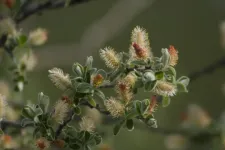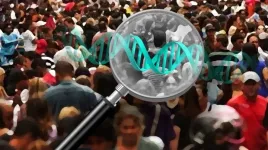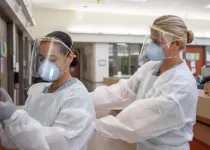(Press-News.org) A 15-year experiment on Arctic shrubs in Greenland lends new understanding to an enduring ecological puzzle: How do species with similar needs and life histories occur together at large scales while excluding each other at small scales? The answer to this question has important implications for how climate change might shift species' distributions across the globe.
The study was published today in the journal PNAS and led by the University of California, Davis. Its findings also reveal trends related to carbon sequestration and carbon exchange as the Arctic becomes both greener and browner.
EXPANSION AND EXCLUSION
Like lines of traffic traveling the same roads at the same time without crashing into each other, dwarf birch and gray willow dominate the Arctic landscape, covering and overlapping the same expansive territory, yet excluding each other in nearly indistinguishable microhabitats.
The study suggests that climate and species interactions work together to promote the shrubs at large scales while also promoting their exclusion at small scales. In this case, herbivory by caribou and muskoxen tips the balance in favor of one species or another at small scales but favors their co-occurrence at large scales.
This question of species diversity and co-occurrence versus exclusion has roots in a seminal paper in 1958 by Robert H. MacArthur that is taught in community ecology classes across the world. In that study, five species of warblers in the northeastern United States were observed avoiding each other while making their livings on different parts of the same tree -- some preferring upper or middle branches, others the ground or trunk, for example.
"This is one of the most readily observable phenomena in nature," said lead author Eric Post, director of the UC Davis Polar Forum and a professor in the Department of Wildlife, Fish and Conservation Biology. "Yet what influences species co-variation at both scales is something ecologists have argued about for decades. Our study shows that the same factors can act at both large and small scales with opposite effects on co-occurrence and exclusion. It's fascinating."
BRINGING THE HEAT, EXCLUDING CARIBOU AND MUSKOXEN
For the study, the authors conducted the 15-year experiment at Post's long-time field site in Greenland. There, they recorded how arctic shrub abundance and composition changed in response to experimental warming treatments and to a treatment that fenced off large sections of tundra to exclude herbivores, such as caribou and muskoxen.
The experiment confirmed what recent theoretical work has suggested: physical conditions, such as climate, combine with species interactions to shape opposing patterns of variation among arctic shrubs at large and local scales.
CLIMATE AND CARBON EXCHANGE
The Arctic is becoming warmer and, in many places, drier. Those conditions favor willow over dwarf birch, the study found, even though birch are more abundant at the study site. While the absence of large herbivores favors almost complete exclusion of willow by birch, warming under those conditions swings the pendulum back slightly in favor of willow. Work in progress at the site also indicates changes in numbers of caribou and muskoxen, suggesting that muskoxen may be driving the balance between willows and birch under warming.
How willow and birch react to such changes will affect how much carbon can be stored. The more shrubs in the Arctic, the more carbon is absorbed from the atmosphere. A diversity of species across the tundra provides a more efficient carbon sponge that just one dominant species of shrub.
"Woody shrubs are expanding across many, but not all, regions of the treeless arctic tundra in what's referred to as 'arctic greening,'" Post said. "We're witnessing the transformation of a sensitive biome right beneath our feet."
This work suggests that large herbivores can interact with warming-driven shrub expansion in complex ways, potentially shaping the carbon landscape.
INFORMATION:
The study's co-authors include Sean Cahoon of the USDA Forest Service in Alaska, Jeffrey Kerby of Aarhus University in Denmark, Christian Pedersen of the Norwegian Institute of Bioeconomy Research, and Patrick Sullivan of the University of Alaska in Anchorage.
The study was funded by the National Geographic Society, NASA and the U.S. National Science Foundation.
CLEVELAND - Evidence suggests particulate matter is the air pollutant which poses the greatest threat to global health. Studies have shown that exposure to particulate matter smaller than 2.5 microns is associated with acute and chronic elevations in blood pressure (BP) as well as hypertension. In the study "The Benefits of Intensive Versus Standard Blood Pressure Treatment According to Fine Particulate Matter Air Pollution Exposure" published this week in the journal Hypertension, researchers at University Hospitals (UH) and Case Western Reserve University (CWRU) ...
A paper by a multidisciplinary team of scientists affiliated with various Brazilian institutions, including the University of São Paulo (USP) and the National Cancer Institute (INCA), shows that people of African descent are less likely to find a donor in the National Register of Voluntary Bone Marrow Donors (REDOME) than people with predominantly European ancestry. The paper is published in Frontiers in Immunology.
REDOME is the world’s third-largest bone marrow bank, with more than 5 million registered voluntary donors.
According to the study, having mainly African genetic ancestry can reduce a person’s chances of finding a donor by up to 60%, and having African copies of HLA genes, which must be compatible with ...
Obesity and its duration are significant risk factors for type 2 diabetes, cardiovascular events, multiple cancers and decreased quality of life. According to the Centers for Disease Control and Prevention, obesity affects 20.6% of adolescents ages 12-19 in the United States, meaning a potential lifetime of dealing with this condition. Complications from obesity can also result in a potentially decreased life expectancy of five to 20 years for these youth. In a new study published in Pediatrics, researchers at Children's Hospital Colorado (Children's Colorado) have found that both younger and older adolescents have similar weight loss, resolution of high blood pressure and high cholesterol, nutritional impacts and improvement in quality of life after bariatric surgery. These results ...
Article Title: "Game theory to enhance stock management of Personal Protective Equipment (PPE) during the COVID-19 outbreak"
Funding: The authors received no specific funding for this work.
Competing Interests: The authors have declared that no competing interests exist.
Article URL: https://journals.plos.org/plosone/article?id=10.1371/journal.pone.0246110
INFORMATION: ...
Decoy protein intercepts spike of coronavirus
Virus prevented from infecting human cells
Protein may be new way to treat and prevent COVID-19
CHICAGO --- Northwestern Medicine scientists have developed a new protein that acts as a trickster to neutralize the COVID-19 infection in a human kidney organoid, a miniature organ made from stem cells in the lab.
The protein is a variant of ACE2 (angiotensin converting enzyme-2), the receptor the coronavirus uses to enter and infect human cells. The modified protein intercepts the S spike of the coronavirus and fools it into binding to it rather than the real ACE2 receptor in cell membranes. ...
NEW YORK, NY (Feb. 1, 2021)--Errors in the way chromosomes are packed into antibody-producing B cells appear to play a role in the development of B cell-related blood cancers, according to a new study by researchers at Columbia University Vagelos College of Physicians and Surgeons.
The findings could lead to new biomarkers for predicting the onset of these cancers and to a new class of cancer therapies that prevent or correct harmful changes in genome architecture.
The study was published online Feb. 1 in the journal Nature Genetics.
Antibodies are made by immune cells called ...
Taking a particular type of medication to treat enlarged prostate is associated with a reduced risk of developing Parkinson's disease, according to a large observational study led by researchers at the University of Iowa, with colleagues in Denmark and China.
The findings, published Feb. 1 in JAMA Neurology, provide compelling evidence that terazosin, and similar medications, might have the potential to prevent or delay the development of Parkinson's disease.
The new study used data on almost 300,000 older men from two large, independent patient datasets--the Truven ...
A new kind of wearable health device would deliver real-time medical data to those with eye or mouth diseases, according to Huanyu 'Larry' Cheng, Dorothy Quiggle Career Development Professor in the Penn State Department of Engineering Science and Mechanics (ESM).
Cheng recently published a paper in Microsystems & Nanoengineering on new micro- and nano-device technology that could revolutionize how certain health conditions are monitored and treated.
"We sought to create a device that collects both small and large substances of biofluids such as tears and saliva, which can be analyzed for certain conditions on a rapid, continuous basis, rather than waiting on test results from samples in a lab," he said.
The sensors would be placed near the tear duct or mouth to collect samples, ...
Winter survival of honey bee colonies is strongly influenced by summer temperatures and precipitation in the prior year, according to Penn State researchers, who said their findings suggest that honey bees have a "goldilocks" preferred range of summer conditions outside of which their probability of surviving the winter falls.
The results of this study, which used several years of survey data provided by the Pennsylvania State Beekeeper's Association and its members, enabled the development of a tool for forecasting honey bee winter survival to support beekeepers' management decisions, the researchers said.
Honey bees contribute more than $20 billion in pollination services to agriculture in the United States and generate another ...
Toxin-antitoxin (TA) systems are now known to negatively control plasmid replication, according to Thomas Wood, Biotechnology Endowed Chair and professor of chemical engineering in the Penn State College of Engineering.
Plasmids, or extra-chromosomal bits of DNA, allow bacteria to evade antibiotics, making the antibiotics ineffective in halting a bacterial infection.
The presence or absence of plasmids impacts a bacterium's resistance to antibiotics and its ability to cause infection -- important points related to fighting bacterial infections, according to Wood.
"Each year, there are at least 700,000 deaths worldwide because of bacterial infections, a growing number that is projected to increase to 10 million by 2050," Wood said. "And of course, the effectiveness ...




